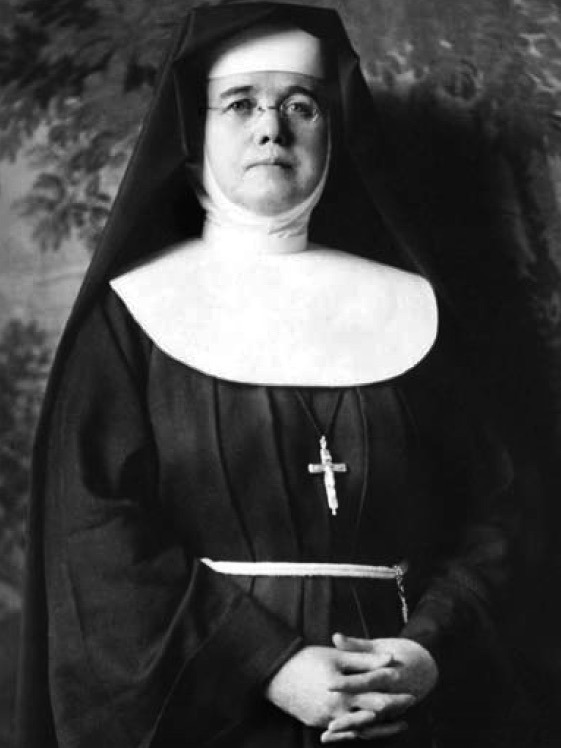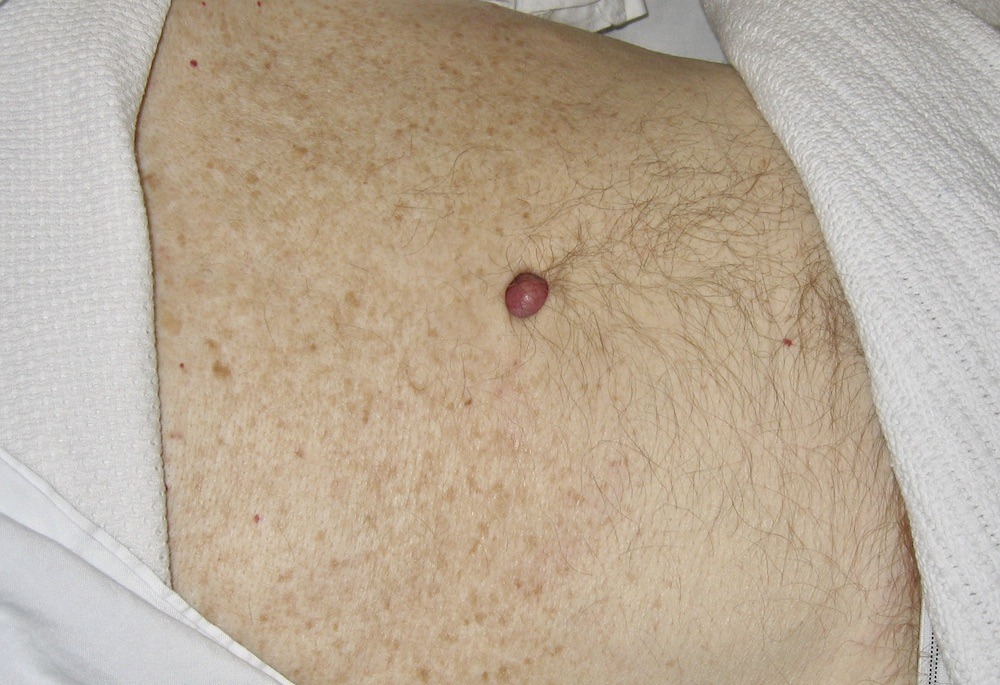Sister Mary Joseph

Julia Dempsey; Sister Mary Joseph (1856-1939) was an American Catholic nun, nurse, and hospital administrator.
Sister Joseph Dempsey was the longest-reigning administrator of St. Mary’s Hospital in Rochester (1892-1939). She was surgical assistant to William James Mayo (1861-1939).
Sister Joseph’s administrative and nursing skills contributed greatly to the success of the Mayo brothers in establishing their surgical practice and the Mayo Clinic. The original surgical building at Saint Mary’s Hospital is now named “Joseph Building” in her memory.
Eponymously recognised for noting that a ‘nodule’ in the umbilicus was often associated with advanced malignancy (Sister Joseph’s sign)
Biography
- Born on May 14, 1856 in Salamanca, New York
- 1878 – Entered the Third Order Regular of St. Francis of the Congregation of Our Lady of Lourdes in Rochester, New York taking the name Sister Mary Joseph
- 1889 – Assigned to the new St. Mary’s Hospital, Rochester. She learned nursing from Edith Graham, a graduate nurse who later became the wife of Charles Horace Mayo (1865 – 1939)
- 1890-1915 First surgical assistant to Dr. William James Mayo (1861-1939)
- 1892-1939 Nursing superintendent of St. Mary’s Hospital
- 1906 – Opened St. Mary’s Hospital School for Nurses, which trained both sisters and laywomen. Founded the Sister Joseph Endowment Fund
- 1915 – First Vice-President of the newly founded Catholic Hospital Association of the United States and Canada
- Died on March 29, 1939, Rochester, Minnesota.
Medical Eponyms
Sister Joseph nodule (1928)
Observation and palpation of the umbilicus reveals a hard and infiltrated nodule. Metastatic carcinoma of the umbilicus characteristically associated with adenocarcinoma from the stomach, large bowel, ovary, or pancreas. For many patients the nodule is the first sign of malignancy.

Sister Joseph observed the presence of a palpable cutaneous nodule in the umbilical area in patients diagnosed with abdominal malignancy while prepping the abdomen prior to surgery. She reported her clinical observations to Dr. William James Mayo.
William Mayo first reported the condition as “pants-button umbilicus” (without credit to Sister Mary Joseph) in a lecture to the Cincinnati Academy of Medicine in 1928 and recorded in the Proceedings of the Staff Meeting of the Mayo Clinic that same year.
The ‘pants-button’ umbilicus does not seem to be so well known. In many doubtful cases, examination and palpation of the umbilicus will reveal that it is hard and infiltrated, perhaps not prominently.
Mayo 1928
Henry Hamilton Bailey (1894-1961) was a British surgeon and influential publisher, who named this sign in recognition of Sister Joseph in his textbook Demonstration of Physical Sign in Clinical Surgery in 1949.
In advanced intra-abdominal carcinoma, a neoplastic nodule can sometime be seen or felt at the umbilicus. This is known as Sister Joseph’s nodule*.
* Sister Joseph of the Mayo Clinic imparted this clinical observation to Dr William Mayo
Hamilton-Bailey 1949: 227
however… the sign had been previously published…many times
1846 – Walter Hayle Walshe (1812-1892) reported the presence of umbilical metastases
Professor Hermann of Strasburg perished, thus according to Lobstein: an enormous tumor had originated in the pelvis, and in the course of six months extended to the umbilicus, without causing pain or any notable symptom; the patient attended to scientific pursuits to the day of his death
Walshe 1846
1876 – J-F Catteau, having observed several cases, writes in his 1876 thesis ‘De l’ombilic et de ses modifications dans les cas de distension de l’abdomen’
«Toutes les fois qu’il existera une ulcération ombilicale, il faudra songer à la péritonite cancéreuse »
Whenever there is an umbilical ulceration, it will be necessary to think of cancerous peritonitis
1896 – Edouard Quénu (1852-1933) and Longuet reported 36 cases of umbilical metastases, 14 of which originated from carcinoma of the stomach.
La tumeur primitive de l’ombilic est rare; l’apparition d’un cancer de l’ombilic doit donc nous faire soupçonner l’existence d’un cancer viscéral. La moitié des cancers secondaires de l’ombilic ont leur point de départ dans cette portion de la muqueuse digestive qui s’étend du cardia au rectum. L’apparition d’un cancer secondaire de l’ombilic comporte un pronostic fatal a bref délai.
Primary umbilical tumor is rare; the appearance of umbilical cancer should therefore make us suspect the existence of visceral cancer. Half of secondary umbilicus cancers start in this part of the digestive mucosa that extends from the cardia to the rectum. The appearance of secondary umbilicus cancer has a fatal prognosis at short notice.
1913 – The treatise by Quénu et Longuet was reduced to a summary by Thomas Stephen Cullen (1869-1953) in his review of carcinoma of the umbilicus
Quénu and Longuet, in their exhaustive monograph on secondary cancer of the umbilicus (1896), say that the lymphatics constitute an excellent avenue along which abdominal carcinomata may reach the umbilicus. They describe the manner in which the lymphatics of the pyloric end of the stomach and those of the duodenum communicate with those of the under surface of the liver. From this point there is a free lymphatic communication with the umbilicus along the suspensory ligament…in their paper they also mention two cases of cancer of the uterus with secondary nodules at the umbilicus.
Cullen TS, 1913
Controversies
Sister (Mary) Joseph nodule. Should we use the name Mary?
Before Vatican II in 1965, all Franciscan nuns took the name of Mary as a prefix to an additional name. It has been argued that Sister Joseph (as per the original declaration by Hamilton Bailey in 1949) should be the appropriate terminology for the nodule rather than the more commonly used Sister Mary Joseph nodule.
Records from the hospital and Mayo clinic use Sr Mary Joseph and Sr Joseph interchangeably throughout official records and so either term is correct
References
Biography
Eponymous terms
- Walshe WH. Post-peritoneal cellular tissue. In: The nature and treatment of cancer. 1846: 311-312
- Catteau J-F. De l’ombilic et de ses modifications dans les cas de distension de l’abdomen. Thése de Paris, 1876 [referred to as Thése Catteau]
- Quénu E, Longuet L. Du cancer secondaire de l’ombilic et de sa valeur séméiologique. Revue de chirurgie. 1896; 16: 97 -133. [PDF]
- Besson E. Contribution à l’étude du cancer de l’ombilic. These, Université de Paris 1901
- Cullen TS. Carcinoma of the umbilicus. In: Embryology, anatomy, and diseases of the umbilicus. 1913
- Mayo WJ. Metastasis in cancer. Proceedings of the Staff Meeting of the Mayo Clinic. 1928; 3: 327.
- Hamilton Bailey. Non-acute abdominal conditions. In: Demonstrations of Physical Signs in Clinical Surgery. 11th edition. 1949: 227
- O’Neill TW, O’Brien AAJ. Sister (?Mary) Joseph’s nodule. Irish Medical Journal. 1987; 80: 296.
- Schwartz IS. Sister (Mary?) Joseph’s nodule. N Engl J Med. 1987; 316(21): 1348-9.
- Steensma DP. Sister (Mary) Joseph’s nodule. Ann Intern Med. 2000 Aug 1;133(3):237.
- Miller T, Ashworth J, Richards S. Sister Mary Joseph nodule. BMJ. 2015; 351: h5224
- Rastogi V et al. Abdominal Physical Signs and Medical Eponyms: Part III. Physical Examination of Palpation, 1926–1976. Clin Med Res. 2019; 17(3-4): 107-114.
Eponym
the person behind the name
